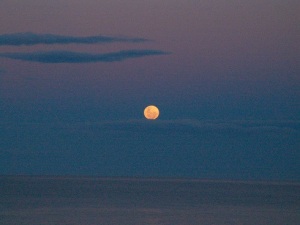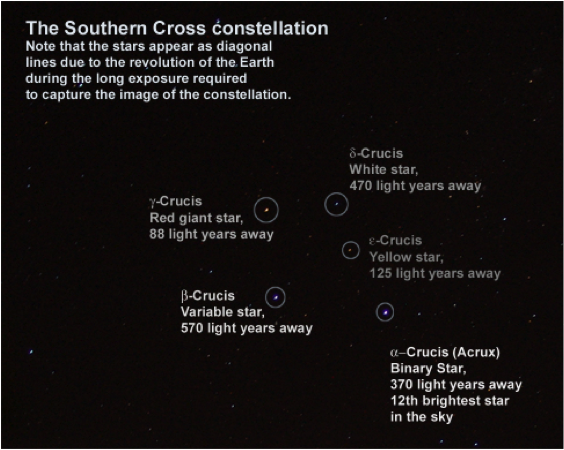If you have read The light we photograph: daylight then you will know that little we see on the Earth is more then a handful of nanoseconds from the past. But what about when we turn our eyes (and our camera lenses) towards the night sky and star-spangled darkness of space? From when does that light come?
Nearby things – very recent light
When we photograph the moon in the night sky, we are capturing it as it appeared about a second earlier. The light that describes its appearance required only about 1.3 seconds [1] to travel the average 384,000 kilometers from the surface of the moon to the surface of our lens. Using the same logic, we see Mercury as it appeared 5 minutes ago, Venus 2.3 minutes ago, Mars 4.3 minutes ago, Jupiter 1/2 hour ago, Saturn over an hour ago, Uranus almost three hours ago and Neptune four hours ago.
To try to imagine the speed needed to travel such vast distances in such a short time, consider this: on average, the time it takes for a human to blink is about 1/3 of a second.[2] That means that light from the moon speeds across 384,000 kilometers of space to you in the time it takes you to blink at the moon 4 times in a row. (Try it one day, it’s fun.)
But now consider this: when we look at the moon between blinks, our eyes are being touched by light photons that only recently flew off the surface of the Sun. The moonlight we see connects us in a very real way to the Sun and the Moon. That soft glow comes from light that left the Sun’s surface, sped 8 minutes and 150 million kilometers through intrasteller space to the Moon where it ricocheted off some dusty rock in our direction across another 384,000 kilometers in about a second, and that’s what just landed in our eyes.
Far away and long ago things
When we look up at the night sky or point our camera at a constellation, it is a moment of high drama. At that instant of time our eyes are intercepting a stream of light photons that may have been traveling towards us since before we were born, or before the first Pterodactyl took to the air, or even before our solar system settled out of the gas cloud from which it was born. More than just a temporary flare of light on the rods and cones at the back of our eyeballs, these photons are a physical connection between us and distant suns of our galaxy, and galaxies extending into the depths of space and time.
Imagine for a moment a relatively nearby constellation, the Southern Cross. Its stars range from 88 to 570 light years away. For those of us in the southern hemisphere, it is a special feature of the night sky. But consider for a moment the journey of the light we are seeing. The light of the furthest star we see burst from its sun’s surface and headed towards us at about the same time King Henry VI founded Eton College in the 15th century. By contrast, the light from the nearest star began its journey only a few years before the New York stock market crash of 1929.
These timeframes are so extended that we cannot be sure that the objects we see in the sky are still there. It would not be at all out of the question for one of these stars to have exploded in a supernova 80 years ago and we’re still waiting to get the news.
But of course 88-570 light years away is not as far away and long ago as we have been able to peer into the universe around us. Recent deep field photographs from the Hubble telescope have revealed light from stars in galaxies from more than thirteen billion years ago. [3]
Video still capture from HubbleSite [4]
The more one contemplates the nature of spacelight, the more dizzying it becomes. For example, when we see a planet such as Saturn, our eyes are being impacted by light photons that travelled from the Sun and made a billion kilometer each way trip to and from Saturn. Think of it, when we see Saturn in the night sky, photons of light that actually touched the rings of Saturn an hour earlier are now touching us.
On the night I took the photograph of the Southern Cross, other photons of light from these same stars (the ones that didn’t hit Earth) whizzed past us. Those photons are now eight light years (about 80 trillion kilometers) away and streaking off a rate of 27 billion kilometers a day. Perhaps on some clear night thousands of years and heptillions of kilometers distant those photons will impact upon the alien eyes (or photographic device) of an inhabitant of some other planet.
___________________________________________
PHOTOGRAPHS:
Moon over the ocean, Tuross Head, 2008 by Sabrina Caldwell; other than resizing for web use, no alterations have been done to the photograph. Southern Cross constellation, 2006 by Sabrina Caldwell; original photograph unaltered other than resizing for web use, overlaid with text information. hubble deep field video still from HubbleSite http://hubblesite.org/hubble_discoveries/hubble_deep_field/resources.php
—————————————————————-




